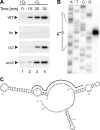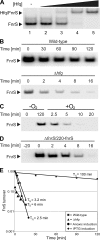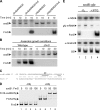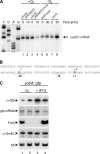Translational regulation of gene expression by an anaerobically induced small non-coding RNA in Escherichia coli
- PMID: 20075074
- PMCID: PMC2856277
- DOI: 10.1074/jbc.M109.089755
Translational regulation of gene expression by an anaerobically induced small non-coding RNA in Escherichia coli
Abstract
Small non-coding RNAs (sRNA) have emerged as important elements of gene regulatory circuits. In enterobacteria such as Escherichia coli and Salmonella many of these sRNAs interact with the Hfq protein, an RNA chaperone similar to mammalian Sm-like proteins and act in the post-transcriptional regulation of many genes. A number of these highly conserved ribo-regulators are stringently regulated at the level of transcription and are part of major regulons that deal with the immediate response to various stress conditions, indicating that every major transcription factor may control the expression of at least one sRNA regulator. Here, we extend this view by the identification and characterization of a highly conserved, anaerobically induced small sRNA in E. coli, whose expression is strictly dependent on the anaerobic transcriptional fumarate and nitrate reductase regulator (FNR). The sRNA, named FnrS, possesses signatures of base-pairing RNAs, and we show by employing global proteomic and transcriptomic profiling that the expression of multiple genes is negatively regulated by the sRNA. Intriguingly, many of these genes encode enzymes with "aerobic" functions or enzymes linked to oxidative stress. Furthermore, in previous work most of the potential target genes have been shown to be repressed by FNR through an undetermined mechanism. Collectively, our results provide insight into the mechanism by which FNR negatively regulates genes such as sodA, sodB, cydDC, and metE, thereby demonstrating that adaptation to anaerobic growth involves the action of a small regulatory RNA.
Figures






Similar articles
-
sRNA roles in regulating transcriptional regulators: Lrp and SoxS regulation by sRNAs.Nucleic Acids Res. 2016 Aug 19;44(14):6907-23. doi: 10.1093/nar/gkw358. Epub 2016 May 2. Nucleic Acids Res. 2016. PMID: 27137887 Free PMC article.
-
Reprogramming of anaerobic metabolism by the FnrS small RNA.Mol Microbiol. 2010 Mar;75(5):1215-31. doi: 10.1111/j.1365-2958.2010.07044.x. Epub 2010 Jan 12. Mol Microbiol. 2010. PMID: 20070527 Free PMC article.
-
Acidic Residues in the Hfq Chaperone Increase the Selectivity of sRNA Binding and Annealing.J Mol Biol. 2015 Nov 6;427(22):3491-3500. doi: 10.1016/j.jmb.2015.07.010. Epub 2015 Jul 18. J Mol Biol. 2015. PMID: 26196441 Free PMC article.
-
The small RNA regulators of Escherichia coli: roles and mechanisms*.Annu Rev Microbiol. 2004;58:303-28. doi: 10.1146/annurev.micro.58.030603.123841. Annu Rev Microbiol. 2004. PMID: 15487940 Review.
-
How to find small non-coding RNAs in bacteria.Biol Chem. 2005 Dec;386(12):1219-38. doi: 10.1515/BC.2005.140. Biol Chem. 2005. PMID: 16336117 Review.
Cited by
-
sRNAs and the virulence of Salmonella enterica serovar Typhimurium.RNA Biol. 2012 Apr;9(4):437-45. doi: 10.4161/rna.20480. Epub 2012 Apr 1. RNA Biol. 2012. PMID: 22546935 Free PMC article. Review.
-
In silico 'fishing' using known small regulatory RNA (sRNA) candidates as the decoy from Escherichia coli, Salmonella typhi and Salmonella typhimurium manifested 14 novel sRNA candidates in the orthologous region of Proteus mirabilis.Mol Biol Rep. 2018 Dec;45(6):2333-2343. doi: 10.1007/s11033-018-4397-z. Epub 2018 Oct 3. Mol Biol Rep. 2018. PMID: 30284142
-
Oxygen-dependent regulation of SPI1 type three secretion system by small RNAs in Salmonella enterica serovar Typhimurium.Mol Microbiol. 2019 Mar;111(3):570-587. doi: 10.1111/mmi.14174. Epub 2018 Dec 12. Mol Microbiol. 2019. PMID: 30484918 Free PMC article.
-
In vivo versus in vitro protein abundance analysis of Shigella dysenteriae type 1 reveals changes in the expression of proteins involved in virulence, stress and energy metabolism.BMC Microbiol. 2011 Jun 24;11:147. doi: 10.1186/1471-2180-11-147. BMC Microbiol. 2011. PMID: 21702961 Free PMC article.
-
Small RNA OxyS induces resistance to aminoglycosides during oxidative stress by controlling Fe-S cluster biogenesis in Escherichia coli.Proc Natl Acad Sci U S A. 2024 Nov 12;121(46):e2317858121. doi: 10.1073/pnas.2317858121. Epub 2024 Nov 4. Proc Natl Acad Sci U S A. 2024. PMID: 39495911 Free PMC article.
References
Publication types
MeSH terms
Substances
LinkOut - more resources
Full Text Sources
Other Literature Sources
Molecular Biology Databases

